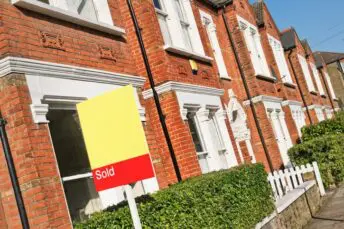House Price Watch Nov 2023
House price growth slowed from 7.2% to -1.4% over the past year and transactions are likely to be 12% lower than 2019, the last 'normal' housing market benchmark. While house prices held steady this month, activity and house prices are expected to remain subdued into 2024. Affordability remains stretched but with mortgage rates easing slightly, we may begin to see buyer confidence begin to return in the months ahead.
What’s happening nationally
House prices remained stable over the past month and fell on average -1.4% over the past year.
Rightmove, reporting asking prices in November reported the biggest fall in house prices. Land Registry reporting October figures also indicated a fall in house prices, while Halifax and Nationwide both recorded a slight increase in house price growth. All of the indices report a fall in annual house price growth.
Indices based on:
Land Registry – registered property transactions in October.
Nationwide & Halifax – mortgage valuations in November.
Rightmove – asking prices posted on Rightmove in November.
*Rightmove is not included in the index average as the basis for its index is different (asking price vs agreed sale price)
| Index reports: | Monthly change | Annual change |
|---|---|---|
| Land registry | -0.7% | -1.2% |
| Nationwide | +0.2% | -2.0% |
| Halifax | +0.5% | -1.0% |
| Rightmove | -1.7% | -1.3% |
| Average change | 0% | -1.4% |
House prices in your area
Land Registry reported a fall in house prices in most areas over the past month with the biggest declines in London (-3.1%), the East of England (-1.5%) and the East Midlands (-1.3%).
In the past year, most regions in England and Wales experienced a fall in house prices. Annual house prices fell the most in London (-3.6%), Wales (-3%), the East of England (-2.3%), the South East (-2.0%) and the east Midlands (-1.7%).
Average house prices remain highest in London (£515K) and lowest in the North East (£161K).
House price falls are most evident for flats/ maisonettes (-2.5%) and terraced properties (-2.0%)and relatively stable for semi-detached (-0.3%) and detached properties (0%) according to October Land Registry data.
| UK Region | Average price £ | Monthly change | Annual change |
|---|---|---|---|
| England | |||
| Nothern Ireland | |||
| Scotland | |||
| Wales | |||
| North West | |||
| Yorkshire and The Humber | |||
| North East | |||
| West Midlands | |||
| East Midlands | |||
| South West | |||
| East of England | |||
| South East | |||
| London |
| UK City | Average price | Annual change |
|---|---|---|
Market Monitor
There were 81K transactions in November, down -1.2% on October, 22% lower than November 2022. 81K transactions is in the lowest range we have seen in the last decade.
Demand continues to fall as do new instructions from sellers this month. Average stock per agent is down month on month.
Despite weakness in overall buyer demand, the first-time buyer market has held up relatively well. Rightmove says: “The number of sales being agreed for studio, one-bed, and two-bed properties is just 7% lower than 2019’s level, compared to four-bed detached houses and all five-bed plus properties, where agreed sales are 14% behind 2019.”
Time to sell has increased to 66 days up from 62 days last month and above the 12 month average of 58 days.
How busy is the market?
- Not busy
- Normal
- Very busy
- Transactions down slightly in November, still at a ten year low
- Total transactions in November 81K
- -1.2% from last month
- -22% from November last year
Homes for sale vs homebuyers
- Good availability of homes
- Normal
- Shortage of homes
- Buyer enquiries down(-14% RICS); buyer demand continues to fall
- Seller enquiries down (-5% RICS); sales instructions continue to fall
- Average stock per agent 52; down from 54 last month (incl under offer/ Sold STC Rightmove)
Average speed of sale
- Fast
- Normal
- Slow
- 66 days to find a buyer, up from 62 days last month (12 month average 58 days Rightmove)
What the experts say
Rightmove - agent's view

“We’d expect to see a drop in new seller asking prices in the last couple of months of the year, as serious sellers start to separate themselves from discretionary sellers and cut through the Christmas noise with an attractive price to secure a buyer. However, the larger than usual drop this month signals that among the usual pricing seasonality, we are starting to see more new sellers heed their agents’ advice and come to market with more enticing prices to stand out from their over-optimistic competition. However, key indicators point to a year that so far has been better than many predicted. Average asking prices are just 3% below May’s peak. The pandemic driven stock shortage is over, with available properties for sale now just 1% behind 2019. Two consecutive Base Rate holds, much steadier fixed-rate mortgage deals on offer, and a general feeling that rates may have now peaked, are giving some assurance and confidence to buyers.”
Nationwide

“UK house prices rose by 0.2% in November, after taking account of seasonal effects. There has been a significant change in market expectations for the future path of Bank Rate in recent months which, if sustained, could provide much needed support for housing market activity. While mortgage rates are unlikely to return to the lows prevailing in the aftermath of the pandemic, modestly lower borrowing costs, together with solid rates of income growth and weak/negative house price growth, should help underpin a modest rise in activity in the quarters ahead.”
Halifax

“UK house prices rose for the second month in a row, up by +0.5% in November or £1,394 in cash terms, with the average house price now sitting at £283,615. Over the last year, despite the wider economic headwinds, property prices have held up better than expected, falling by a relatively modest -1.0% on an annual basis, and still some £40,000 above pre-pandemic levels. The resilience seen in house prices during 2023 continues to be underpinned by a shortage of properties available, rather than any significant strengthening of buyer demand. That said, recent figures for mortgage approvals suggest a slight uptick in activity levels, which is likely as a result of an improving picture on affordability for homebuyers. With mortgage rates starting to ease slightly, this may be leading to increased buyer confidence, seeing people more inclined to push ahead with their home purchases.”
Zoopla (Hometrack)

“Annual house price inflation is -1.1%, down from +7.2% a year ago. House price falls are starting to moderate as sales improve. Market sentiment is improving due to rising incomes and an initial decline in mortgage rates. An increase in available supply, up a quarter on last year, is also boosting choice and supporting sales. Buyers and sellers are becoming more aligned on pricing, reducing the downward pressure on values. We expect the steady momentum in new sales that has developed over the final part of 2023 to continue into early 2024. While mortgage rates are edging lower, affordability remains a key challenge for mortgage-reliant households who are making home moving decisions. The modest decline in house prices over the year means UK housing still looks 10-15% overvalued at the end of 2023. We expect this position to improve over 2024 as incomes rise and house prices drift 2% lower over the year.”
RICS

“The November 2023 RICS UK Residential Survey results point to a slightly improved outlook for market activity going forward, with sentiment supported by a modest easing in mortgage rates over recent weeks. That said, near-term sales expectations are only marginally positive at this stage, while most other indicators tracked remain in negative territory (albeit to a lesser extent than previously).”




